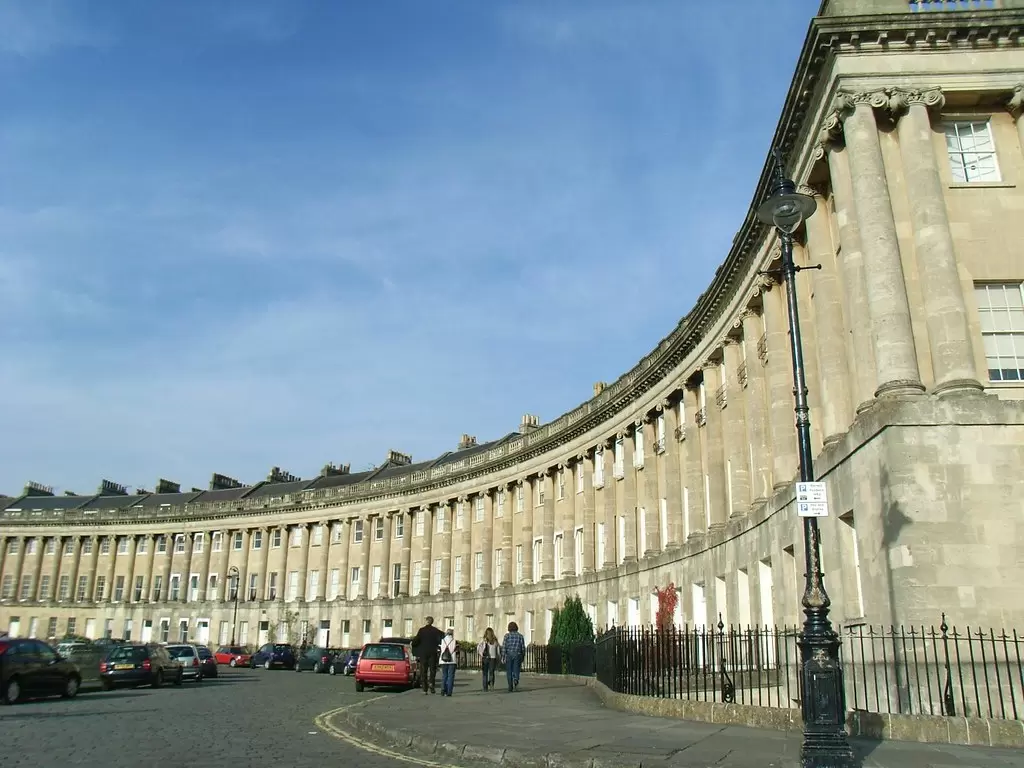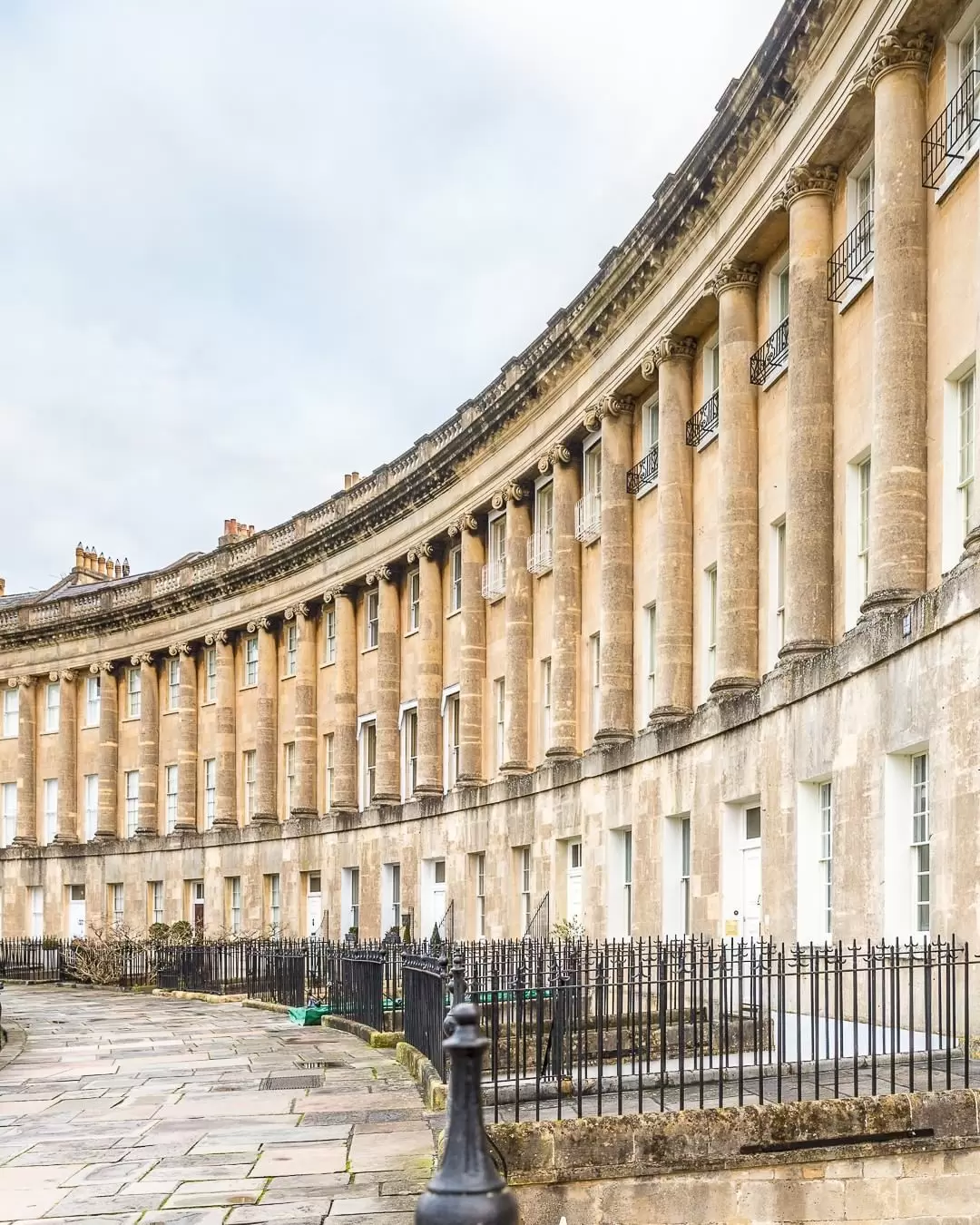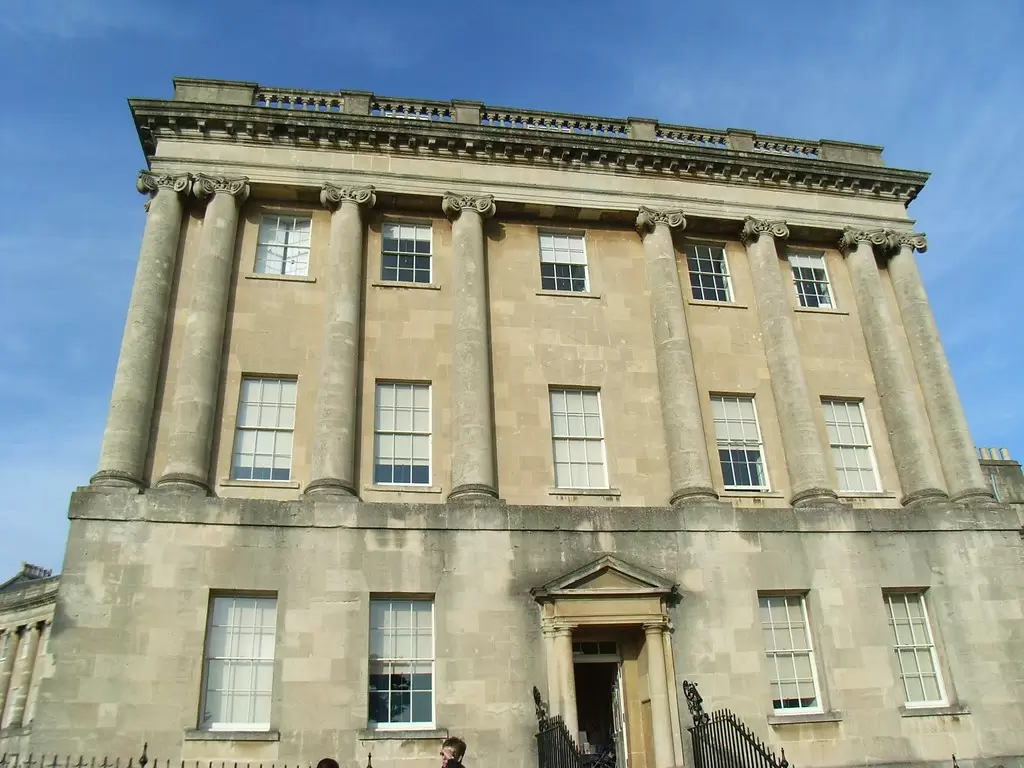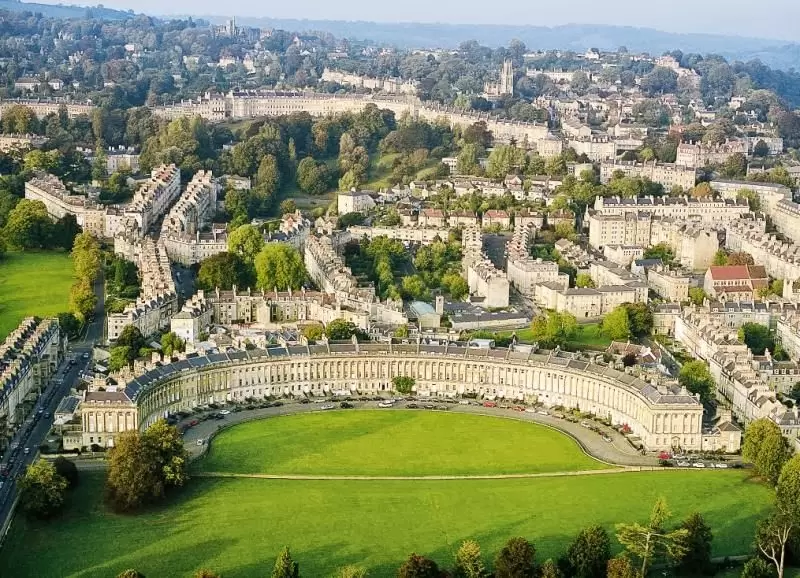The Royal Crescent, Bath, İngiltere'de bulunan ve 18. yüzyılın sonlarında inşa edilen bir dizi Georgian dönemi konutlarıdır. Bu konutlar, mimari açıdan önemli bir örnek teşkil eder ve İngiltere'nin en ünlü turistik yerlerinden biridir. Royal Crescent, 30 adet üç katlı evden oluşur ve hepsi aynı tasarıma sahiptir. Her evin önünde bir bahçe ve bir araba park yeri bulunur. Konutların tasarımı, o dönemde popüler olan neo-klasik tarzda yapılmıştır. Bu tarz, sade ve simetrik hatlara sahip binaların inşa edilmesini öngörür. Royal Crescent, Bath'ın tarihi merkezinde yer alır ve ziyaretçilerin şehrin tarihi dokusunu keşfetmelerine olanak tanır.
The Royal Crescent: Bath's Iconic Georgian Homes

The Royal Crescent is one of the most iconic landmarks in the city of Bath, England. This impressive row of 30 Georgian townhouses was built between 1767 and 1775 and is considered one of the finest examples of Georgian architecture in the world. The crescent is a testament to the elegance and grandeur of the Georgian era, and it has become a symbol of Bath's rich history and cultural heritage.
The Royal Crescent was designed by the architect John Wood the Younger, who was inspired by the Roman Colosseum. The crescent is a semi-ellipse, with the two ends of the row forming a circular shape. The townhouses are built of Bath stone, a type of limestone that is native to the area and gives the buildings their distinctive golden color. Each house has three floors and a basement, and many of them have been converted into luxury apartments or hotels.
The Royal Crescent has been the home of many notable residents over the years, including writers, artists, and politicians. The most famous resident was probably the novelist Jane Austen, who lived in one of the townhouses for a short time in 1801. Today, the Royal Crescent is a popular tourist attraction, and visitors can take a guided tour of the interior of one of the townhouses to see what life was like in Georgian times.
The Royal Crescent is not just a beautiful piece of architecture; it is also an important part of Bath's history and culture. The crescent has been featured in many works of literature and art, and it has become a symbol of the city's elegance and sophistication. Whether you are a history buff, an architecture enthusiast, or simply a lover of beauty, the Royal Crescent is a must-see destination in Bath.
Discovering the History of The Royal Crescent's Georgian Residences

The Royal Crescent is one of the most iconic landmarks in the city of Bath, England. It is a row of 30 Georgian townhouses that were built between 1767 and 1775. The crescent is a masterpiece of Georgian architecture and is considered one of the finest examples of Palladian architecture in the world. The Royal Crescent is a Grade I listed building and is a popular tourist attraction.
The history of the Royal Crescent's Georgian residences is fascinating. The crescent was designed by John Wood the Younger, who was a prominent architect in the 18th century. The crescent was built on a hill overlooking the city of Bath and was designed to provide a panoramic view of the city. The crescent was built in the Palladian style, which was popular in the 18th century. The Palladian style was characterized by symmetry, proportion, and classical motifs.
The Royal Crescent's Georgian residences were originally built as private homes for the wealthy. The houses were designed to be spacious and luxurious, with high ceilings, large windows, and elegant interiors. The houses were also designed to be functional, with separate areas for living, dining, and sleeping.
Over the years, the Royal Crescent's Georgian residences have been home to many famous people. The most famous resident of the crescent was Jane Austen, who lived at number 25 for a short time. Other famous residents include William Pitt the Younger, who was the Prime Minister of England, and Sir Isaac Pitman, who invented shorthand.
Today, the Royal Crescent's Georgian residences are still some of the most desirable homes in Bath. Many of the houses have been converted into apartments, and some are still used as private homes. The crescent is a popular tourist attraction, and visitors can take a tour of the houses to learn more about their history and architecture.
In conclusion, the Royal Crescent's Georgian residences are a testament to the beauty and elegance of Georgian architecture. The crescent is a must-see attraction for anyone visiting Bath, and the history of the houses is fascinating. The Royal Crescent's Georgian residences are a reminder of a bygone era when architecture was an art form, and homes were built to be both beautiful and functional.
Exploring the Architecture of The Royal Crescent's Georgian Era Homes

The Royal Crescent is a famous landmark in Bath, England, known for its stunning Georgian era homes. The crescent-shaped row of 30 terraced houses was designed by John Wood the Younger and built between 1767 and 1774. The architecture of these homes is a testament to the Georgian era's elegance and sophistication.
The Royal Crescent's homes are built in the Palladian style, which was popular in the 18th century. The style is characterized by symmetry, proportion, and classical elements such as columns, pediments, and domes. The homes are made of Bath stone, a type of limestone that is native to the area. The stone gives the homes their distinctive honey-colored appearance.
The homes in The Royal Crescent are three stories tall and have a basement level. The ground floor has large windows and a central doorway with a fanlight and sidelights. The first and second floors have smaller windows and are adorned with decorative moldings and cornices. The homes have a flat roof with a balustrade, which provides a stunning view of the surrounding area.
The interiors of the homes are just as impressive as the exteriors. The homes have high ceilings, large windows, and spacious rooms. The rooms are decorated with ornate plasterwork, marble fireplaces, and elegant furnishings. The homes also have beautiful gardens, which were designed to complement the architecture of the homes.
The Royal Crescent's homes are a testament to the Georgian era's architectural style and elegance. The homes' Palladian style, Bath stone construction, and stunning interiors make them a must-see for anyone interested in architecture and design. The Royal Crescent is a true gem of Bath and a testament to the city's rich history and culture.
The Royal Crescent: A Glimpse into Georgian Society and Culture

The Royal Crescent is a famous landmark located in Bath, England. It is a row of 30 terraced houses that were built between 1767 and 1775. The crescent is a prime example of Georgian architecture and is considered one of the most iconic buildings in the city.
The Royal Crescent was designed by John Wood the Younger, who was a prominent architect during the Georgian era. The crescent was built during a time when Bath was a popular destination for the wealthy and elite. The houses were designed to be grand and luxurious, with large windows, high ceilings, and intricate details.
The Royal Crescent is not only a beautiful example of Georgian architecture, but it also provides a glimpse into Georgian society and culture. During the Georgian era, Bath was a hub for social activity, and the Royal Crescent was no exception. The houses were occupied by wealthy families who would host lavish parties and events. The crescent was also home to many notable figures, including writers, artists, and politicians.
The Royal Crescent is a testament to the opulence and grandeur of Georgian society. It is a reminder of a time when the wealthy and elite lived in luxury and extravagance. Today, the crescent is a popular tourist attraction and is considered one of the most important examples of Georgian architecture in the world.
In conclusion, the Royal Crescent is not just a beautiful building, but it is also a window into the past. It provides a glimpse into Georgian society and culture and is a reminder of a time when Bath was a hub for social activity and opulence. The crescent is a testament to the grandeur and extravagance of the Georgian era and is a must-see for anyone interested in history and architecture.
The Royal Crescent: A Must-See Destination for Fans of Georgian Architecture

The Royal Crescent is a stunning example of Georgian architecture located in Bath, England. It is a must-see destination for anyone interested in this style of architecture, as it is one of the most iconic and well-preserved examples of Georgian architecture in the world.
The Royal Crescent was designed by John Wood the Younger and built between 1767 and 1774. It is a row of 30 terraced houses, all of which are Grade I listed buildings. The crescent shape of the buildings was designed to provide a sense of grandeur and to take advantage of the stunning views of the surrounding countryside.
The architecture of the Royal Crescent is characterized by its use of classical elements, such as columns, pediments, and pilasters. The buildings are made of Bath stone, a type of limestone that is native to the area and has a warm, honey-colored hue. The facades of the buildings are adorned with intricate carvings and decorative details, such as swags, urns, and rosettes.
One of the most impressive features of the Royal Crescent is the uniformity of the buildings. Each house is the same height and width, and the facades are all identical. This creates a sense of harmony and balance that is typical of Georgian architecture.
The Royal Crescent has been the subject of many paintings, photographs, and films over the years, and it continues to be a popular tourist destination. Visitors can take a guided tour of the buildings, or simply stroll along the crescent and admire the architecture from the outside.
In conclusion, the Royal Crescent is a must-see destination for anyone interested in Georgian architecture. Its stunning design, use of classical elements, and uniformity make it one of the most iconic examples of this style of architecture in the world. Whether you are an architecture enthusiast or simply appreciate beautiful buildings, the Royal Crescent is a sight not to be missed.

Yorumlar